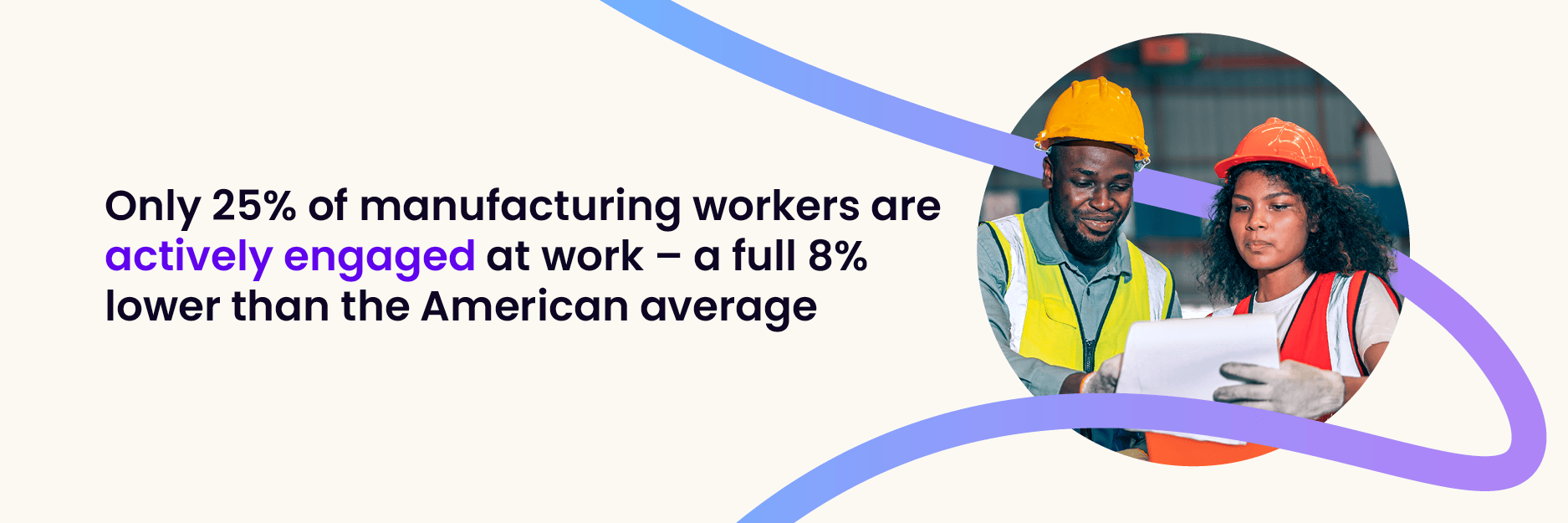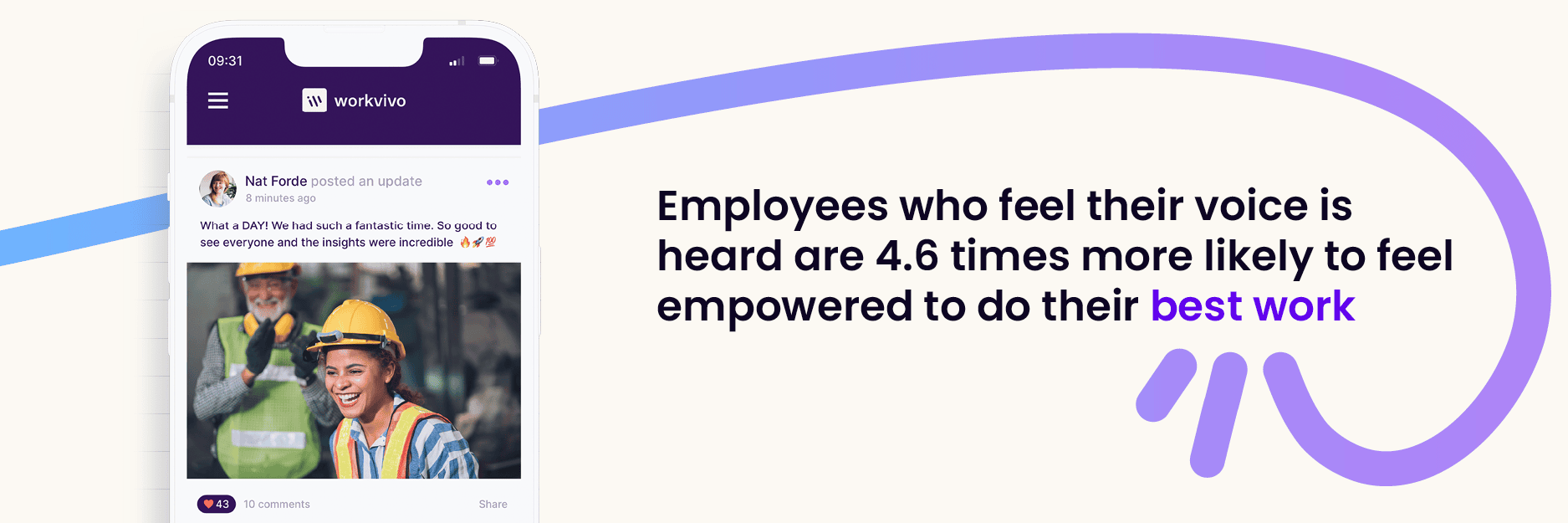Internal Comms for Manufacturing – The Ultimate Guide

Lisa Ardill
Content Editor at Workvivo
19 Oct 2022

Only 25% of manufacturing staff are actively engaged at work. Want to turn things around? Here’s everything you need to start nailing your internal comms for manufacturing workers.
Deskless workers account for 80% of the global workforce. Instead of working from behind a computer screen, they interact with customers on the shop floor, make deliveries out on the road, or do important work in factories, mills, and plants.
For manufacturing companies, your frontline employees are the lifeblood of your organization. Without them, you wouldn’t have a business at all. But, according to a Gallup poll, only 25% of manufacturing workers are actively engaged at work – a full 8% lower than the American average.

Connecting with manufacturing workers has always been a challenge for internal communicators. These employees are busy and don’t have time to waste reading long comms emails. They don’t work from computers, so it’s not as easy to simply reach out to them through your employee intranet. Plus, since comms professionals typically work out of the corporate office and write their communications from this perspective, manufacturing staff might not see their experiences reflected in any communications they do receive.
But without designing an internal communications strategy to connect with your employees out on the factory floor, you have no way of knowing whether they fully understand your corporate policies, the latest safety procedures, or your company’s mission and values.
And perhaps more importantly, they have no way of sharing their valuable knowledge, ideas, and insights and helping you to create a smoother, more profitable operation.
What is employee internal communications?
Employee internal communications is an umbrella term that covers all the ways that organizations communicate with their employees. This includes traditional top-down communications like corporate newsletters or emails, and more modern, worker-focused techniques like employee listening, feedback loops, and peer-to-peer recognition.
Why is internal communications important in today’s workplace?
Without internal communications, your employees would have no idea about essential policy updates or legislation changes affecting your industry. More broadly, you would have no way of getting your brand values, mission, and strategy across to your employees – and your employees would have no way of giving you feedback on how your company is running.
Simply put, internal communications are a vital part of any organization – especially in the context of the Great Resignation. As we discussed back in May, it’s getting harder and harder for employers to attract and retain top talent. These days, companies need to do more to actively engage their employees and attract new ones in a competitive market.
A well-thought-out, targeted internal communications strategy can:
- Boost employee engagement and productivity: Employees are likely to be more engaged in their work if they know they’re working together towards a common goal. Plus, communication strategies that encourage employees to share their opinions help to make them feel valued, which is also a significant driver of engagement. According to a Salesforce survey, employees who feel their voice is heard are 4.6 times more likely to feel empowered to do their best work.
- Improve the employee experience and boost retention: When employees are engaged at work, they’re much less likely to look for another job elsewhere. A Gallup poll found that highly engaged employees were between 24% and 59% less likely to leave.
- Increase efficiency and solve problems more quickly: When a serious problem arises, do you want your employees to have to deal with it alone? Or to have access to a range of resources and team members who might be able to help them? An effective communications strategy connects your employees together so that they can solve problems quickly and work more efficiently.
- Save the company money: Poor communications in the workplace can have a devastating effect on the company’s bottom line: in an SHRM study of 400 companies with over 100,000 employees, the average company reported a loss of $62.4 million per year due to inadequate communication.

Despite all of this, 60% of organizations don’t have a long-term internal communication strategy in place. Even if you do, you still might fall short if you’re not embracing modern communication methods – especially where manufacturing workers are concerned.
The fact is, the old methods just don’t cut it: comms emails often go unread, and traditional intranet platforms are often clunky, outdated, and poorly used. And these methods are even more likely to fail at engaging manufacturing staff since they’re usually deskless and might not have a company email address or digital profile.
The challenges of internal comms for manufacturing companies
Communicating effectively with your workforce is a challenge in any industry, but manufacturing employees can be particularly difficult to reach. Since these workers don’t usually have access to computers, many organizations rely on messages being passed down through regional management, which means that they can be diluted or even out-of-date before they get to the factory staff.
In fact, a survey from 2015 found that 82% of manufacturing CEOs found it difficult or very difficult to talk to employees on the plant floor. This may be part of the reason why turnover is traditionally very high in manufacturing compared to other industries – according to one survey, 43% of manufacturing managers reported an average annual turnover of 20% or more. Manufacturing staff are also some of the least engaged employees in any industry – a problem that could be solved through more effective employee communications.

Here are some of the specific challenges that communications professionals face when trying to connect with manufacturing employees:
- Safety concerns: Manufacturing employees need to be aware of the safest ways to work and the actions they should take if something goes wrong. In manufacturing, poor communication can easily lead to accidents. Best practices and advice also change regularly, which means that communication needs to be an ongoing process. Despite this, many manufacturing companies rely on old-fashioned techniques like storing their safety policies in a binder in a cupboard somewhere on site. Since information stored in this way can easily go out of date and is only accessible by one person at a time, this is clearly not a suitable solution. It also only works as a responsive method of workplace safety and does nothing to prevent hazardous conditions from becoming a problem in the first place.
- A changing workforce: As of 2021, over 25% of the manufacturing workforce in the US is 55 years old or over. Many plants will see a large proportion of their workforce retiring over the next ten years. According to a Deloitte study, this could result in a shortage of over 2 million manufacturing workers by 2030. But despite a traditional negative view of the manufacturing industry, there is reason for hope. According to Forbes, 32% of Gen Z-ers who are entering the workforce are considering a career in manufacturing. However, these younger employees have different expectations for the workplace and require more feedback from management, digital connectivity, and a mobile-first communications environment. Attracting and retaining these new employees will be a significant challenge for manufacturing companies in the years to come – and internal comms could be a big part of the solution.

- Outdated tech: Many manufacturing companies deliver comms to their employees through public-access computer kiosks or terminals on the factory floor. While this allows employees to access HR materials like timesheets, calendars, and rotas, employees can only connect to them when on-site and away from their workstations. They can only be accessed by one employee at a time and are unsuitable for transmitting instant, critical messages to your deskless employees. As younger generations enter the workforce, manufacturing companies will need to update their comms strategy so that employees can access information anywhere, at any time. Safety concerns mean it’s also vital for manufacturing companies to be able to send out instant, mass communications to everyone – and ensure they’ve received them.
7 ways to connect with manufacturing workers through your internal communications strategy
Employees on the factory floor are notoriously hard to reach with internal communications. This is especially true in large organizations with multiple locations, which may span different countries and include employees who don’t all speak the same language.
But engaging your manufacturing employees with a well-thought-out and targeted communications strategy can have big results for your organization. When your employees have all the information they need to do their jobs effectively, you can increase operational efficiency, improve workplace safety, and boost engagement among those hard-to-reach employees – which can help with retention too.
Here are seven ways to optimize your communications so that they not only reach employees on the frontline but inspire them and bring them together as well.
1. Create a single source of information with a company intranet
Organizations often use a variety of different methods to communicate with their employees on the factory floor. They may have a binder containing important safety information and require employees to fill out and file physical incident reports when an accident occurs. They may have a monthly newsletter that goes out by email, and post schedules and reminders on a physical noticeboard or a computer system that employees can access through on-site computer kiosks.
But there are a number of problems with these methods. Self-service computer terminals can only be accessed on-site and require employees to leave their workstations to view HR materials and other content. And storing vital safety information in one location is a bad idea in an industry where workplace safety is such an important factor.
Most importantly, these methods don’t allow for communication between employees at different locations. Plus – let’s face it – a note on a bulletin board or a dry, corporate email isn’t going to do much to inspire people.
One solution is to set up an employee intranet to act as a hub for all of your employee communications. If you’ve used a corporate or school intranet before, don’t panic: we’ve come a long way since the clunky, web-based, and poorly used systems of the early ‘00s. Modern intranet solutions come with all sorts of features that allow you to connect your workforce together, whether they work at a desk or on the plant floor.
2. Ditch the computer kiosk for a mobile app
If you do set up a company intranet, you need to ensure that your manufacturing employees can access it. But the thing about deskless workers is that they don’t typically have desks or computers. Even if they can use computer kiosks at work, this doesn’t give them on-demand access to information or the ability to receive time-critical messages when you need them to.
What they do have – if they’re anything like 97% of Americans, anyway – is a smartphone. This means that you should opt for a solution with a mobile app that all of your employees can download on their own devices, giving them access to your all-important communications from anywhere.
This will be especially important over the next decade, as retiring employees are increasingly replaced by Gen Z-ers. These employees have grown up using smartphones and are accustomed to receiving information this way. By connecting with your younger workforce where they already are, you can have the best possible chance of breaking the cycle and building a generation of manufacturing workers who are engaged and satisfied at work.
3. Decentralize top-down communication
When you manage communications for a large enterprise with multiple locations, anything you can do to decentralize your messaging is a step in the right direction. Instead of the comms department approving all content and acting as a gatekeeper for information-sharing, try distributing information to regional managers so that they can customize it for the staff in their region.
Then, they’ll send it on to sub-regions, where it will be refined even more. This way, staff on the factory floor will get highly targeted information that’s actually relevant to them – resulting in greater engagement with your communications.
4. Encourage bottom-up comms across locations
Your comms strategy should also include plenty of opportunities for bottom-up and cross-functional communications. Think about it: when a new employee starts at one of your locations, who do they go to with their questions? Probably not the corporate office.
Manufacturing workers have a wealth of knowledge of what it’s like to work on the frontline of your organization. And they’re in the perfect position to share this with new starters and even management. However, they can’t spread their knowledge if they’re only in communication with the team in their own location.
One of the best ways to empower your manufacturing workers through internal communications is to provide opportunities for communication across all levels, regardless of location. This way, they can share their tips and best practices across different locations, improving performance all round.
And encouraging feedback from your frontline employees can help with retention too: employees who don’t feel comfortable giving upward feedback are 16% more likely to leave their jobs.

5. Go digital with your safety protocols
In a manufacturing setting, workplace safety and emergency preparedness are some of the most important applications of your internal communications strategy. And requiring employees to physically retrieve (potentially outdated) safety information in the event of an emergency simply isn’t good enough.
If you haven’t yet gone digital with your safety protocols and procedures, now is the time to start. All employees should be able to access information like updated protocols and contact details for external agencies from wherever they are – which means putting them on your employee intranet, accessible through a mobile app.
Using a mobile app also allows you to send push notifications to all employees when you need to urgently alert them to dangerous conditions. Features like acknowledgment buttons can help ensure that everyone has got the message.
6. Reward and recognize top performers
As humans, we all like to receive recognition when we do good work. However, manufacturing workers typically don’t have much contact with the higher-ups in their organization and may only receive praise privately from their direct line managers or supervisors. While this is still valuable, publicly recognizing your employees’ efforts and achievements is a more effective way of encouraging them and others.
Public recognition can hugely affect employee engagement and productivity since people who feel that their work is valued are motivated to put in more effort. And it can help with retention too: 63% of those who feel recognized at work say they’re “very unlikely” to look for a new job in the next three to six months, according to one survey. This is a particularly important practice in manufacturing, an industry where retention is typically lower than average.

So, how can you make employee recognition part of your communication strategy? One idea is to send out a regular email, blog post, or piece of content that your deskless employees can access on their employee app, shining a light on individual and team achievements. Some intranet or employee communications platforms even come with this function integrated, making it even easier for your employees to give their colleagues the praise they deserve.
7. Focus on the employee experience to boost retention
Employee communications shouldn’t be about stilted company updates from your senior leadership team. Apart from anything else, manufacturing workers don’t have a lot of time to spend reading comms messages, so there’s a good chance they’ll skip the dry corporate emails altogether.
Instead, a good communications strategy should be focused on the employee experience, bringing people together and engaging them so that they truly feel like part of a team. When it comes to manufacturing workers, consider stepping away from long pieces of content that they probably don’t have time to read and opt for bite-sized formats that are engaging and concise.
Formats like employee shout-outs, competitions, and interesting conversations that everyone can contribute to will always do a better job of improving the employee experience than boring top-down emails highlighting the company’s latest achievements.
5 must-have features for an internal communications platform
There are many parts to a good communication strategy. It needs to involve carefully crafted, well-branded content. It should also allow your entire workforce to contribute to the conversation, which requires careful planning as well. However, none of that will work if it’s not sitting on a powerful platform that’s designed to bring employees together.
There are many different platforms out there, and they all come with their own unique features – the one you choose will depend on the specific needs of your organization.
However, there are some key features that you shouldn’t compromise on. Here are some of the must-haves to look for when you’re choosing a platform:
1. An intuitive and familiar interface
If you want your employees to actually use the platform you choose, you need to make sure it’s accessible and inviting. That means looking for solutions with an interface that’s pleasant and easy to navigate. This is especially important where manufacturing staff are concerned since they typically don’t have time to learn the ins and outs of a whole new complicated program.
2. A mobile app
If you want to engage manufacturing workers, you need to meet them where they are – which means looking for solutions that are accessible on a smartphone. More than this, the solution you choose should be mobile-first, not just a website that’s technically accessible on a smartphone if you turn your phone on the side and wait for it to load.
3. Push notifications
There are times when you need to get a message out to your entire organization – and know they’ve received it. This is a particular consideration when we’re talking about manufacturing workers since there might be urgent safety announcements that you need everyone to see. To enable this, use an app with a push notification feature. Then, when you need to tell everyone about a piece of machinery being updated or a new safety protocol, you’ll know they’ve got the message.

4. Pulse surveys and polls
Pulse surveys are a great way to keep an eye on what’s actually going on in your organization in terms of employee engagement. And you can use polls to get a quick snapshot of your employees’ opinions, for example when you’re looking to implement a new policy. This is a particularly effective tool for manufacturing workers since they know better than anyone what life on the factory floor is actually like. Often, things seem like a great idea in head office, and it takes someone on the ground to point out an obvious problem. Any communication platform you choose should make it easy for you to send out these surveys and polls and for your manufacturing staff to respond.
5. Opportunities for bottom-up and cross-functional communication
The most effective communication doesn’t come from the top down. To really empower your manufacturing workers, you need a solution that allows them to communicate with each other regardless of location, discuss problems, and even connect on a social level. Bonus points if your platform has social media-like functions like comments and emoji reactions, which all help to make things more fun and engaging.
Introducing Workvivo
Workvivo is an employee communication platform with the power to bring your whole organization together – whether they’re at their desks or working hard on the factory floor. Our platform helps your employees to communicate, share ideas, and better understand your company’s core mission and values.
Employees from all parts of your organization can post updates, ask questions, and give shout-outs, and they’ll appear to other employees in a personalized news feed. Our employee recognition features can help you to build a culture of real-time, spontaneous peer-to-peer recognition. And you can easily send out polls and surveys that employees can respond to with just a few taps of the screen.
And did we mention? Our platform is fully accessible through our mobile app, which means it’s the perfect tool to engage your manufacturing workers.
Want to learn more? Book a personalized demo to understand how Workvivo can help you supercharge your communications and set your manufacturing business up for success.

